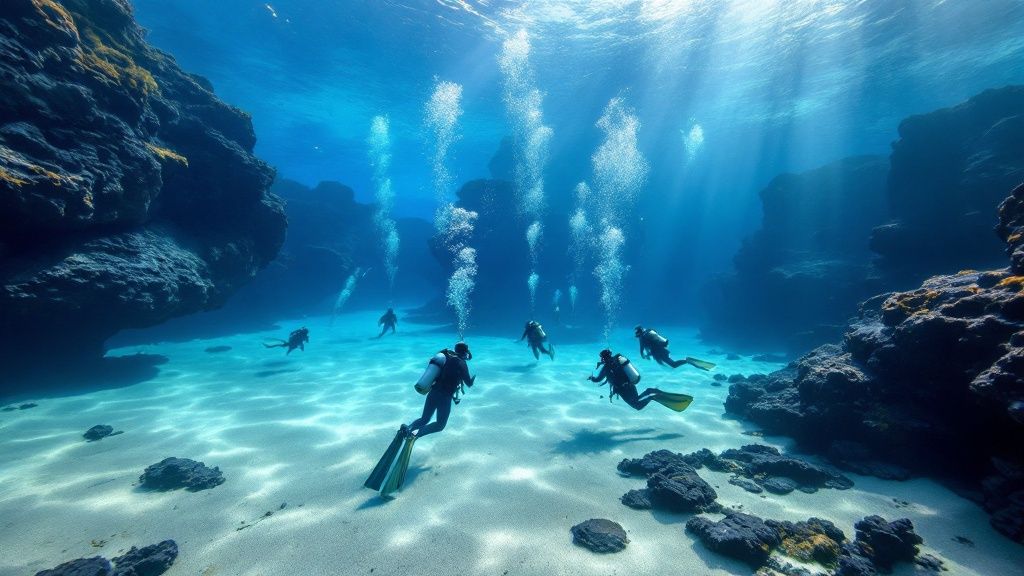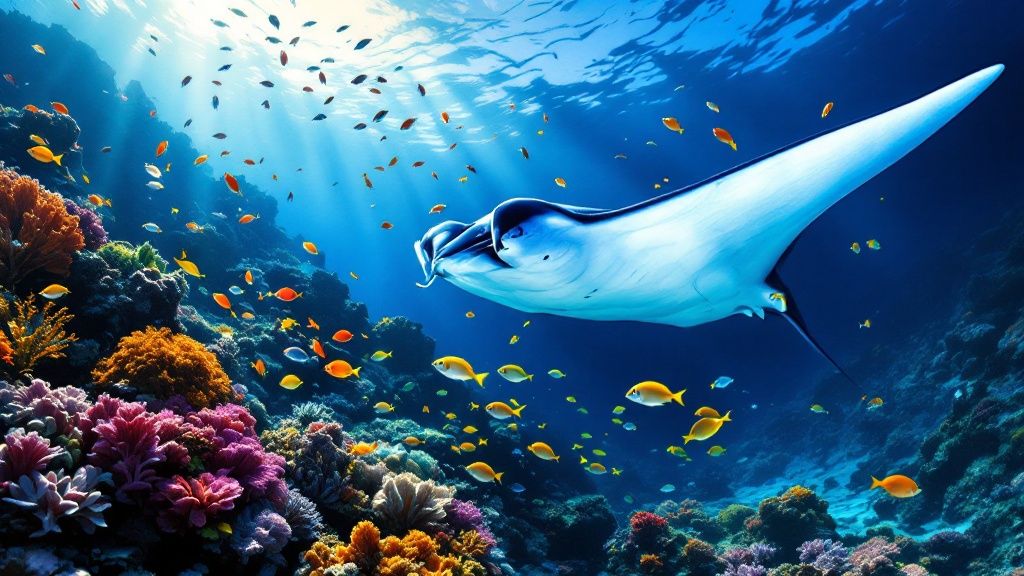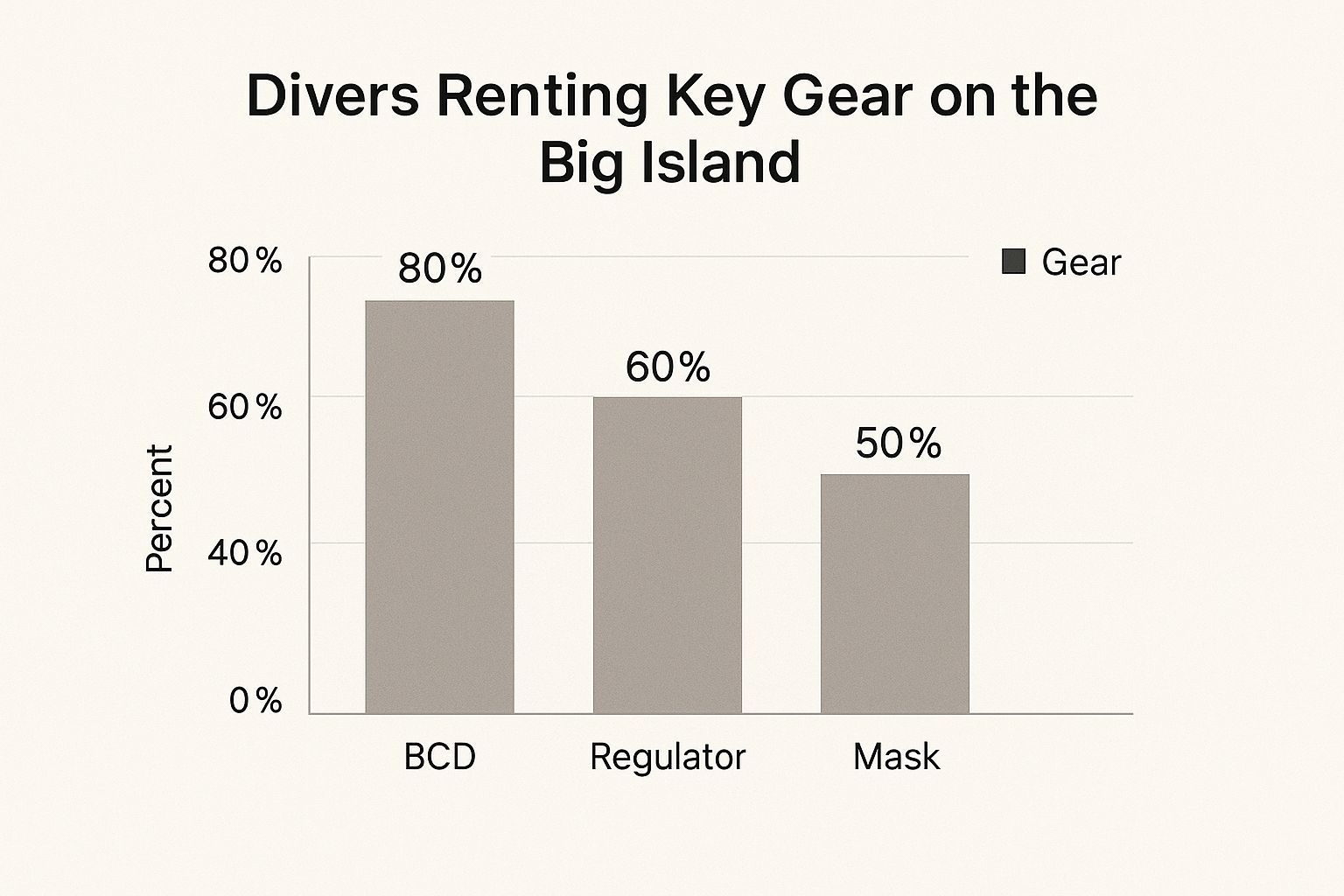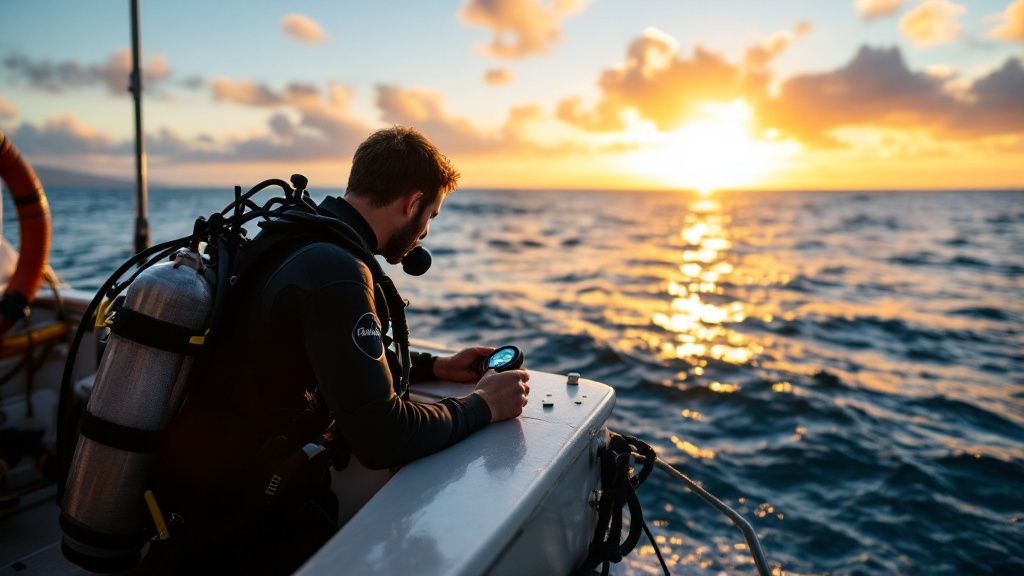Plunging Into Paradise: The Big Island Divers Hawaii Experience
The moment you descend into the ocean with Big Island Divers Hawaii, you're transported to an otherworldly realm. Imagine yourself drifting through crystalline waters, exploring lava tubes sculpted by ancient volcanoes, and encountering vibrant coral reefs teeming with life. This is the unparalleled beauty that awaits you on a dive with Big Island Divers Hawaii.
These unique underwater landscapes, formed by volcanic activity, are a testament to the raw power of nature. This geological history has created a haven for an astounding array of marine life. The porous lava rock, for instance, offers shelter for countless creatures, from tiny invertebrates to larger fish seeking refuge. This intricate environment fosters a thriving and complex ecosystem.
The clear, nutrient-rich waters surrounding the Big Island further enhance the exceptional visibility and biodiversity. Thanks to consistently warm water temperatures, typically between 75°F to 80°F (24°C to 27°C), diving in Hawaii is a year-round activity. This comfortable temperature range, combined with the incredible variety of marine life, makes it an ideal destination for divers of all levels. Learn more about diving in Hawaii at PADI.
Unforgettable Encounters With Hawaii's Marine Life
The waters surrounding the Big Island are home to a remarkable diversity of species. You might come face-to-face with a magnificent tiger shark, watch a white tip reef shark navigate its territory, or even witness the graceful dance of manta rays. Big Island Divers Hawaii's commitment to small-group diving makes these encounters even more special. This personalized approach allows for a more intimate and less intrusive experience with the marine environment.
A Commitment to Safety and Conservation
Big Island Divers Hawaii prioritizes both diver safety and environmental stewardship. Their team of expert guides is passionate about providing safe and enriching experiences for divers of all skill levels. They emphasize sustainable diving practices and educate divers on the importance of protecting this invaluable ecosystem.
Each dive becomes not just an adventure, but also an opportunity to learn about and contribute to marine conservation. The guides' expertise goes beyond simply identifying marine life; they provide insights into the intricate relationships that exist within the underwater world.
It's this dedication to education and conservation that truly distinguishes Big Island Divers Hawaii. It transforms a dive into a meaningful exploration of one of Earth's most unique marine ecosystems. This commitment ensures that future generations will be able to experience the wonder of these pristine waters.
Signature Dives That Define Big Island Divers Hawaii
Big Island Divers Hawaii isn't just about exploring typical coral reefs; it's about unique underwater adventures. These signature dives offer encounters with marine life and geological formations found nowhere else. From the ethereal glow of manta rays at night to the mysteries of the deep ocean, these dives cater to various skill levels and interests.
Manta Ray Night Dive: A Bucket-List Experience
The Manta Ray Night Dive is an exceptional experience, drawing divers from around the world. Imagine floating on the surface as these gentle giants glide beneath you, feeding on plankton attracted by the dive lights. This otherworldly spectacle is both mesmerizing and humbling. Big Island Divers Hawaii has developed sustainable practices for these encounters, ensuring minimal disturbance to the manta rays and their habitat.
Black Water Dive: Into the Deep Unknown
For the adventurous, the Black Water Dive offers a glimpse into the mysterious ocean depths. As darkness descends, pelagic creatures ascend from the abyss, creating a surreal and captivating scene. Stories from expert divers reveal the fascinating details behind these unusual encounters. This dive is perfect for a unique and thrilling experience. You might be interested in: How to master big island diving.
Lava Tube Dives: Exploring Volcanic History
Hawaii's volcanic origins created a unique underwater landscape, including fascinating lava tubes. Big Island Divers Hawaii offers exclusive dives into these formations, letting you swim through underwater caverns sculpted by ancient eruptions. This dive provides a unique perspective on the island's geological history. The Big Island is renowned for its rich marine life and diverse diving. The Manta Ray Night Dive is one of the most famous experiences, attracting divers globally and offering interaction with these creatures in their natural habitat. Big Island Divers offer various tour options, including these night dives. The U.S. diving tourism market is growing, projected to reach $1,585 million by the end of the decade. Discover more insights about Big Island diving.

Tailoring Your Diving Experience
Each signature dive is carefully designed with specific skill requirements, optimal viewing seasons, and expected marine encounters. This allows divers of all levels to find the perfect experience. Whether you're a seasoned diver or a beginner, there is a signature dive waiting to be explored.
Hawaii's Underwater Residents: Extraordinary Marine Encounters

The Big Island, nestled in the heart of the Pacific, is a haven for marine biodiversity. For Big Island divers, this means unparalleled access to an incredible array of underwater life. From the majestic manta ray to the unique beauty of endemic Hawaiian species, every dive is an adventure waiting to unfold.
Manta Rays: The Gentle Giants of Kona
Kona is renowned worldwide as a premier destination for manta ray encounters. These graceful giants, boasting wingspans of up to 18 feet, are a truly remarkable sight. Gliding effortlessly through the ocean, they feed on microscopic plankton, creating a ballet of nature. Learn more about our Manta Ray Night Dive. Big Island Divers Hawaii offers carefully managed night dives, prioritizing the well-being of these gentle creatures while providing divers with an unforgettable experience.
Beyond the Rays: A Diverse Cast of Characters
Manta rays are just the beginning. The Big Island's waters teem with life. During their seasonal migration, humpback whales put on a breathtaking display. Playful dolphin pods often escort dive boats, adding an element of surprise and excitement. And beneath the surface, a variety of shark species, from the common white tip reef shark to rarer pelagic varieties, contribute to the rich biodiversity of the region.
Reef Ecosystems: A Haven for Endemic Species
The volcanic formations continue below the waves, giving rise to unique and intricate reef systems. These reefs offer a diverse habitat for countless marine creatures. Divers can explore a captivating world of coral formations, lava flows, and hidden caverns. These ecosystems support a wealth of endemic Hawaiian fish and invertebrates found nowhere else on Earth. Big Island Divers Hawaii champions responsible diving practices to protect these delicate environments.
Respectful Interactions: Key to Conservation
Big Island Divers Hawaii emphasizes respectful interaction with marine life. Divers are educated on the importance of maintaining a safe distance and avoiding disruptive behavior. This approach minimizes stress on the animals and helps preserve the natural balance. It also enhances the dive experience, allowing for natural and unobtrusive observations of marine life. This dedication to conservation ensures that these remarkable underwater encounters remain for future generations.
Finding Your Perfect Dive: Navigating Experience Options
Big Island Divers Hawaii offers a range of diving experiences for all skill levels and interests, from easy shore dives to exciting boat excursions. Choosing the right dive can seem daunting, but by considering your experience, interests, and diving goals, you can find the perfect underwater adventure.
Shore Dives vs. Boat Excursions: Choosing Your Adventure
For beginners, shore dives offer a comfortable introduction to Hawaii's underwater world. These dives, typically in shallower, calmer waters, allow new divers to gain confidence and practice essential skills. For more experienced divers, Hawaii offers more advanced boat excursions to remote and exciting locations. These dives can take you to deeper waters, vibrant coral reefs, and unique lava formations. When planning your dive, consider tours like Captain Cook Snorkeling Big Island for an informative adventure.
Specialized Dives: Catering to Your Interests
Beyond the standard dive options, Big Island Divers Hawaii offers specialized experiences. Those seeking certification can enroll in comprehensive courses led by experienced instructors. Private charters cater to families and groups wanting a personalized experience, while combination packages maximize underwater time with multiple dives over several days. Check out our guide on Manta Ray Night Dives for another unforgettable experience.
Gearing Up: Equipment and Accessibility
Big Island Divers Hawaii offers comprehensive equipment rentals for travelers who prefer not to bring their own gear. The following infographic shows the percentage of divers renting key equipment on the Big Island:

As illustrated in the infographic, a majority of divers (80%) rent BCDs (Buoyancy Control Devices), while 60% rent regulators, and 50% rent masks. This shows that renting gear is a common practice, allowing divers to travel lighter. It lets them experience the underwater world without transporting heavy equipment. However, bringing your own mask and snorkel is still recommended for optimal hygiene and fit.
To help you choose the perfect diving package, we've created a comparison table detailing the various options offered by Big Island Divers Hawaii.
Big Island Divers Hawaii Package Comparison
| Package Name | Skill Level Required | Duration | Key Features | Price Range | Best For |
|---|---|---|---|---|---|
| Discover Scuba Diving | None | Half-day | Introductory dive with an instructor | $150 – $200 | First-time divers |
| Shore Dive Package | Beginner | Half-day | Two guided shore dives at popular locations | $100 – $150 | Certified beginners |
| Two-Tank Boat Dive | Intermediate | Full-day | Two dives at more remote sites, including lunch | $180 – $250 | Certified divers comfortable with boat dives |
| Manta Ray Night Dive | Intermediate | Evening | Unique experience diving with manta rays | $150 – $200 | Night diving enthusiasts |
| Private Charter | All Levels | Customizable | Personalized dive trip for families or groups | $500 – $1000+ | Families and groups wanting a tailored experience |
| Open Water Certification | None | 3-4 days | Complete scuba certification course | $400 – $600 | Those wanting to become certified divers |
This table summarizes the key features, price range, and ideal diver profile for each package, enabling you to make an informed choice.
Big Island Divers Hawaii accommodates divers of all physical abilities. They are committed to ensuring everyone can enjoy Hawaii’s marine life. This commitment, combined with their expertise and diverse dive options, makes Big Island Divers Hawaii an excellent choice for your next underwater adventure.
The Big Island Divers Hawaii Difference: Why Divers Return

What distinguishes Big Island Divers Hawaii from the competition? And why do so many divers consistently choose them for their underwater adventures? The answer lies in their unwavering dedication to a superior diving experience, from the expertise of their guides to their commitment to sustainable practices. It's a combination that creates lasting memories and encourages repeat visits.
Expert Guides: More Than Just Instructors
Big Island Divers Hawaii places significant emphasis on their instructor development program. This commitment ensures their guides not only possess the required certifications but also a genuine passion for sharing the beauty of the underwater world. They cultivate a deep understanding of marine life behavior and promote respectful observation. This approach transforms each dive into a rich and educational encounter, with guides often highlighting intricate details like the symbiotic relationships between different species.
Small Group Diving: Personalized Attention
Big Island Divers Hawaii embraces a small-group diving philosophy. This approach minimizes the impact on the delicate marine ecosystem and delivers a more personalized experience for each diver. With smaller groups, divers receive individual attention and benefit from closer interaction with their expert guides. This also allows for greater flexibility during the dive. Should an unusual or rare creature appear, the group can easily adjust their course for a closer inspection.
Equipment and Logistics: Seamless and Safe
Big Island Divers Hawaii maintains rigorous equipment maintenance protocols that go above and beyond industry standards. This commitment to safety and performance ensures divers can fully enjoy their underwater explorations. From booking to boat embarkation, their streamlined logistics are designed to maximize your dive time. Every detail is carefully considered, allowing divers to focus on the breathtaking sights awaiting them below the surface. You might be interested in why you should go on a Manta Ray Dive.
Community Involvement: Protecting Hawaii's Waters
Big Island Divers Hawaii's commitment extends beyond individual dives. They actively participate in local marine conservation efforts, recognizing that preserving the health of the ocean is essential for the future of diving. By supporting research initiatives and educating divers about responsible practices, they foster a sense of shared responsibility among the diving community. This dedication to environmental stewardship helps ensure the long-term health and vibrancy of Hawaii’s marine ecosystems.
Local Knowledge: Discovering Hidden Gems
Big Island Divers Hawaii's deep-rooted local knowledge unlocks access to exceptional dive sites often overlooked by other operators. This intimate familiarity with the local waters allows them to tailor dives to specific interests, whether it's exploring hidden lava tubes or encountering rare endemic species. Their passion for Hawaii's underwater world is infectious, creating an enriching experience for divers of all levels. The Big Island of Hawaii is a renowned destination for scuba diving and snorkeling. Operators like Big Island Divers and HONU Sports offer a diverse range of diving experiences, catering to various skill levels. These operators frequently limit group sizes for a more personalized experience. The popularity of the region is reflected in the positive reviews and high ratings these operators receive. Find more detailed statistics here. This blend of expertise, personalized service, and environmental consciousness makes Big Island Divers Hawaii a truly outstanding choice for your Big Island diving adventure.
Planning Your Ultimate Big Island Diving Journey
Turning your diving dreams into a Big Island adventure begins with careful planning. This guide walks you through the essential steps, ensuring a smooth and memorable experience with Big Island divers in Hawaii.
Booking Your Dives: Securing Your Spot
Big Island diving is popular, so booking in advance is essential, especially for unique experiences like the Manta Ray Night Dive. Reserving your spot months ahead, particularly during peak season, ensures you won't miss these highly sought-after underwater encounters. This also gives you plenty of time to arrange other aspects of your trip.
Packing Essentials: Preparing for Hawaiian Waters
Packing for Hawaiian diving means considering both in-water and on-land needs. While Big Island Divers Hawaii provides essential dive equipment rentals, bringing your own mask and snorkel is recommended for hygiene and a personalized fit. Lightweight, quick-drying clothing is perfect for the tropical climate. A rash guard or wetsuit top offers protection from the sun and potential stings. Don't forget reef-safe sunscreen to protect your skin and the coral. For more tips on enjoying the Big Island's coastal beauty, check out our article: Learn more in our article about the 10 best beaches in Kona.
Choosing Your Kona Accommodation: Strategic Locations
The right accommodation enhances your diving trip. Kona offers a variety of options, each with its own perks. Staying near the harbor minimizes travel time to dive sites, while resorts near popular beaches offer easy access for snorkeling and relaxing. Think about your diving priorities and how you want to balance underwater adventures with exploring the island.
Optimizing Your Itinerary: Water Conditions and Marine Migrations
Experienced travelers know the value of planning your itinerary around water conditions and marine migrations. Hawaii offers year-round diving, but some marine life, like humpback whales, are seasonal. Researching these patterns lets you time your trip to maximize your chances of seeing these amazing creatures. Understanding typical water conditions for different times of year also helps you prepare for the best visibility and diving comfort. To help you plan, we've compiled a handy guide:
To make the most of your diving adventure, consult our Seasonal Diving Guide:
Seasonal Diving Guide: Big Island Hawaii
Monthly breakdown of diving conditions and marine life sightings to help divers plan the ideal time for their Big Island diving adventure.
| Month | Water Temperature | Visibility | Marine Life Highlights | Special Events/Considerations |
|---|---|---|---|---|
| January | 72-75°F (22-24°C) | 50-75ft (15-23m) | Humpback whales, manta rays | Whale watching season |
| February | 71-74°F (22-23°C) | 50-75ft (15-23m) | Humpback whales, manta rays | Whale watching season |
| March | 72-75°F (22-24°C) | 60-80ft (18-24m) | Manta rays, reef fish | Transition season |
| April | 73-76°F (23-24°C) | 70-90ft (21-27m) | Manta rays, reef fish, green sea turtles | Start of the dry season |
| May | 75-78°F (24-26°C) | 70-100ft (21-30m) | Manta rays, reef fish, green sea turtles | Dry season |
| June | 77-80°F (25-27°C) | 80-100ft (24-30m) | Manta rays, reef fish, green sea turtles | Dry season |
| July | 79-82°F (26-28°C) | 80-100ft (24-30m) | Manta rays, reef fish, green sea turtles | Dry season |
| August | 80-83°F (27-28°C) | 70-90ft (21-27m) | Manta rays, reef fish, green sea turtles | Dry season |
| September | 79-82°F (26-28°C) | 60-80ft (18-24m) | Manta rays, reef fish, green sea turtles | Transition season |
| October | 77-80°F (25-27°C) | 50-70ft (15-21m) | Manta rays, reef fish | Start of the wet season |
| November | 75-78°F (24-26°C) | 50-70ft (15-21m) | Manta rays, reef fish | Wet season |
| December | 73-76°F (23-24°C) | 50-70ft (15-21m) | Humpback whales begin to arrive, manta rays | Whale watching season begins |
This table provides a general overview. Conditions can vary, so checking current forecasts is always a good idea.
Addressing Travel Challenges: Altitude and Acclimatization
Hawaii's elevation changes can affect divers, particularly regarding ear pressure. Allow yourself time to acclimatize between flights and diving. Staying hydrated and avoiding rapid ascents or descents can help minimize potential issues. Talking to your doctor before your trip about managing ear pressure during dives is also recommended.
Practical Advice: Documentation and Contingency Planning
Having easy access to your dive certification and other important documents simplifies the check-in process. Having a backup plan for potential weather changes is also wise. Big Island Divers Hawaii offers flexible rescheduling, but having alternative activities in mind ensures you enjoy your time, even if unexpected weather arises.
By following these planning tips, you'll be well-prepared for an incredible diving adventure with Big Island Divers Hawaii, creating memories to last a lifetime. Ready to explore this underwater paradise? Book your unforgettable experience with Kona Honu Divers today!
